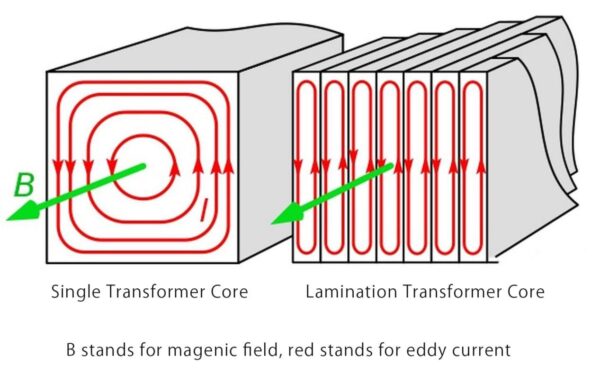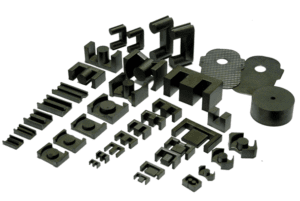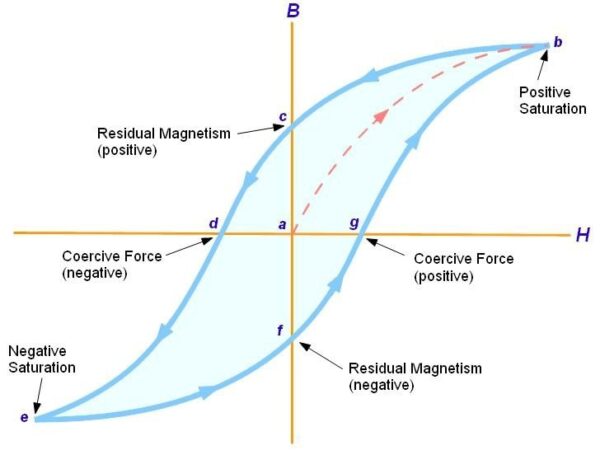The transmission of the magnetic field is accompanied by loss, which can be divided into the following situations:
Eddy current losses
Faraday said that a changing magnetic field can generate electricity, and Lenz said that this kind of electricity will hinder the change of the magnetic field, which is called Back EMF.
The magnetic core of the transformer is in a changing magnetic field, and electricity will also be generated on it, showing a lot of small eddy currents. This phenomenon is called the eddy current effect (Eddy Current).

Eddy current is useful in some cases, for example, home appliance induction cookers are based on the principle of eddy current to heat food. But it will cause losses in the transformer.
There are two methods to solve eddy current losses
- Decompose the large magnetic core into a large number of small magnetic cores, such as laminated, powder, etc.;
- Lamination
For the magnetic chips in the transformer, they are not a single cylinder, but are composed of many layers of magnetic chips. There is insulation between the magnetic chips, which makes the eddy current can only be generated in a very narrow area (the area is perpendicular to the magnetic field). Since the size of the eddy current is proportional to the area, this can greatly reduce the eddy current, and the thinner the magnetic chip, the better the effect.

- Ferrite
Ferrite is a ceramic material with iron oxide as its main component. Most ferrites are magnetic materials used to make permanent magnets (hard ferrites) and transformers (soft ferrites) cores. The high resistivity of ferrite itself can reduce the phenomenon of eddy current.

Transformer cores made by Ferrite
- Hysteresis losses
Hysteresis means that the magnetization of a substance not only depends on the external magnetic field “at that time”, but also on the result of “before” magnetization. Which means, once it is magnetized, the magnetism will remain. To demagnetize, it is necessary to apply a magnetic field in the opposite direction.
We can see the clues from the B-H curve:
- The symbol B refers to the Magnetic Flux Density, which is also named as magnetic induction intensity.
- The symbol H refers to the Magnetizing Force, which is the magnetomotive force per unit length, which can be understood as being proportional to the current passing through the coil;

B-H curve
The evolution process is:
- The origin (a) of the coordinate axis indicates that the material is not magnetized, and then a positive current is input to the coil (the H axis is positive), the material shows magnetism, and the magnetic flux is positive (red dotted line);
- When the current increases to a certain extent, the magnetic flux increases slowly and enters the magnetic saturation state (b);
- If the current stops, the substance can still show magnetism (c);
- The magnetism will disappear only by applying a opposite direction current (d).
In a transformer, the magnetic core is repeatedly magnetized by alternating current. We hope that the magnetic hysteresis of the magnetic core is as small as possible, otherwise more energy will be wasted in overcoming the hysteresis.
The aforementioned ferrites are divided into two types: soft and hard. Soft ferrites are easier to demagnetize, which means that the narrower the shape in B-H (the smaller the distance between d and g):
- Leakage Magnetic Flux
Although the magnetic core has a high magnetic permeability, there is always some magnetic flux that does not propagate along the magnetic core, and they leak to the outside, which is called magnetic leakage.
Magnetic leakage does not participate in the magnetic coupling energy transfer between the primary coil and the secondary coil. They are like inductors, connected in series in a circuit. Inductance acts as an impedance and will produce a voltage drop, so the actual voltage on the transformer will be smaller:
In summary, we introduce the loss phenomenon on the transformer. When the secondary coil is open, a small current will pass through the primary coil. One part of this current is Magnetizing Current, and the other part is the Core Loss Current caused by the loss described in this article. The sum of these two is called Exciting Current.


